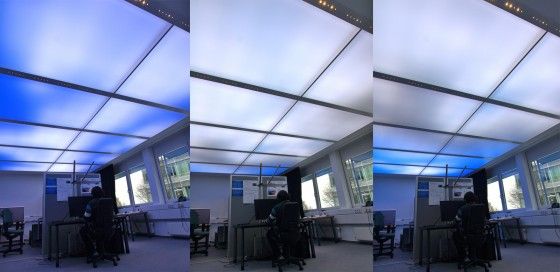One thing that really sucks about living in the Pacific Northwest is the fact that it’s cloudy and raining about nine months of the calendar year. This weather makes people feel like crap all day long at the office and the people feel and look depressed. Wouldn’t it be great if we could somehow change the weather?
Germany’s Fraunhofer, largest organization for applied research in Europe, has recently introduced their latest creation, the ‘Sky Light Sky Bright’, which simulates natural lighting conditions of outdoors for the office. A luminous ceiling made of LEDs extends across an entire room and is able to simulate lighting conditions which resemble those produced by passing clouds – passing on the impression that you are sitting outdoors. The ‘Sky Light Sky Bright’ was created in collaboration with Fraunhofer’s partners at LEiDs GmbH.
Each ceiling tile (50cm x 50cm) consists of 288 LEDs and features a matte white diffuser film which is attached about one foot beneath the lights to ensure that the individual lights are not perceived as such. The diffuser film also creates homogenous lighting that illuminates the room throughout. The system uses a combination of red, blue, green, and white LEDs which projects the full light spectrum and makes it possible to generate over 16 million hues. The system allows the users to keep the lighting static or fluctuate it either gently or rapidly.
A prototype of the ‘virtual sky’ has been developed. It contains 34,560 LEDs spanning across an area of 34 square meters. The “sky” can light up with an intensity of more than 3,000 lux at full power but researchers have found that 500 to 1,000 lux is sufficient enough to create a comfortable amount of lighting. At the present time, the Virtual Sky will costs approximately 1,000 Euros per square meter, although the price is expected to drop once it goes into full production. An exhibit of the system can be seen at the CeBIT Trade Fair in Hannover from March 6-10, 2012.
So this isn’t exactly changing the weather, but it is kind of cool. Although it’s on the expensive side at the moment, it sure would be awesome if this became a mainstream thing in the future.
[Source: Fraunhofer]

